The Detroit Red Wings are one of the most decorated franchises in National Hockey League history. Throughout the years, a vast collection of top-tier talent has donned the Winged Wheel, which has led to the creation of some legendary line combinations.
While each decade of Red Wings’ hockey has produced worthy candidates, I’ve tried to limit this article to the trios that resonate the strongest with the fan base.
Without further ado, let us start with a line that epitomized the gritty side of Red Wings’ hockey.
The Grind Line
Throughout the 1990s, the Red Wings were one of the most skilled teams in the league. Players like Steve Yzerman and Sergei Fedorov were capable of making highlight-reel plays on a nightly basis, but the members of the Grind Line truly embodied the blue-collar city of Detroit.
The line was created by head coach Scotty Bowman in the 1996-97 season, with Joe Kocur, Kris Draper, and Kirk Maltby making up the original trio. While most teams have some form of a checking line, the Grind Line was something special for the Red Wings.
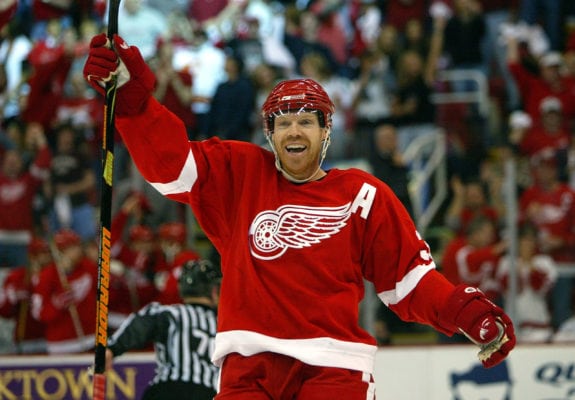
Kocur was an antagonistic tough guy who intimidated opponents with his physicality. Draper was an ace in the faceoff circle and used his blazing speed to play a responsible two-way game. Maltby was tenacious on the forecheck and one of the best agitators of his era.
During Game 1 of the 1997 Stanley Cup Final, the Grind Line found themselves up against another adored trio, the Legion of Doom line from the Philadelphia Flyers. Comprised of John LeClair, Eric Lindros, and Mikael Renberg, this triad terrorized opponents with their size and skill.
You may also like:
- NHL Rumors: Oilers, Red Wings, Flyers
- 9 NHL Teams That Missed in Free Agency
- Why Red Wings’ Quiet Offseason Was the Right Call Long Term
- Red Wings Should Still Pursue John Gibson Trade
- Red Wings’ 10 Hall of Famers on 2002 Stanley Cup Team
Nevertheless, the Grind Line was up to the challenge and hounded them with dogged defensive determination. Even though the Legion of Doom was more skilled, Draper assisted on Maltby’s shorthanded goal to open the scoring in Game 1, while Kocur also netted a goal in the first period, and the Red Wings never looked back.
They swept the Flyers in four straight games to win their first championship in 42 years. Even though the Flyers scored 274 goals during the regular season, they only managed six in the Cup Final, and the Grind Line’s tireless effort played a large part.
The Red Wings would also go on to win the 1998 Stanley Cup championship, but Kocur would retire after the following season. Thankfully, Darren McCarty was a perfect in-house replacement. The rugged winger seamlessly transitioned into Kocur’s role, and the team found themselves back in the Cup Final in the 2001-02 season.
Down 1-0 in the series to the Carolina Hurricanes, Maltby and Draper both scored in a pivotal Game 2 win. The victory sparked the Red Wings to win the next three games, as they captured their third Stanley Cup championship in six seasons.
While Draper and Maltby remained with the team, McCarty saw his contract get bought out due to off-ice issues. He joined the Calgary Flames ahead of the 2005-06 season, and it seemed that the days of the Grind Line had come to an end. Remarkably, because of friends like Draper and his family, McCarty made a comeback in the 2007-08 season.
Related: NHL’s 10 Most Impressive Streaks
The Grind Line was alive once again, but at this point, they were all over the age of 35. Be that as it may, as they did so often before, they helped the Red Wings capture another Stanley Cup.
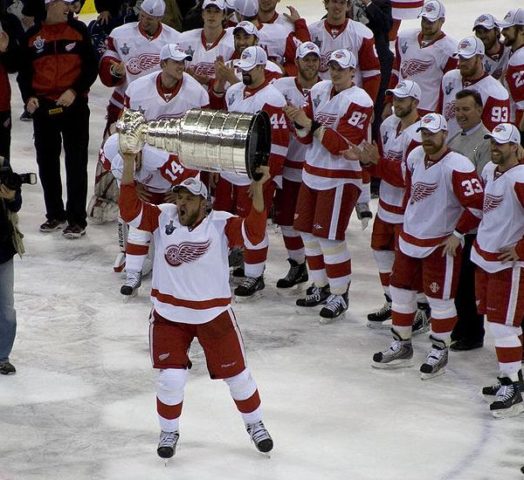
McCarty retired midway through the 2008-09 season, Maltby retired following the 2009-10 season, and Draper did the same after the 2010-11 campaign. The quartet of men who shaped the line over the years had become synonymous with perseverance, toughness, and defensive mastery.
While the Grind Line eventually came to an end after a glorious run, the memories will always remain, and they will forever be part of the tapestry of Red Wings’ history.
The Production Line
The Red Wings were in a funk in 1947. They had not won a Stanley Cup since the 1942-43 season, despite being an annual contender. Due to these disappointing results, a coaching change was on the horizon. Jack Adams focused on managerial duties, and Tommy Ivan became the coach.
Related: ‘Mr. Hockey’ Gordie Howe
Ivan inherited a dependable team, led by veteran centerman Sid Abel. Within the first few weeks of the season, Ivan decided to put Abel alongside two of his younger star wingers, 22-year-old Ted Lindsay and 19-year-old Gordie Howe.
The trio paid immediate dividends, and the media dubbed them the Production Line, referencing Detroit’s booming automotive industry. Lindsay led the league with 33 goals, while Abel and Howe produced 44 points each. They reached the Stanley Cup Final but fell to the mighty Toronto Maple Leafs in four games. While they were not ultimately victorious, the future looked bright in Michigan.
In the 1948-49 season, Abel captured the Hart Trophy, an honor bestowed upon the MVP of the league. The team again made it to the Cup Final on the back of Howe’s herculean effort, but for the second straight year, the Maple Leafs swept them away.
The narrative changed in the 1949-50 season, as the Red Wings finished with the best record in the league. The linemates also finished as the three top scorers in the league, a benchmark never to be replicated by any other NHL team. Lindsay tallied 78 points, winning the only Art Ross trophy of his career, while Abel (69 points) and Howe (68 points) also delivered productive seasons.
Related: “Terrible” Ted Lindsay – Honouring a Lasting Legacy
The Red Wings finally upended the Maple Leafs in a playoff series, as they survived a grueling seven-game series in the semi-final round. It did not come without a cost, however, as Howe suffered a near-fatal brain injury after missing a body check. (from ‘Flashback: Mid-game accident left Gordie Howe close to death,’ Detroit Free Press, 03/21/2015)
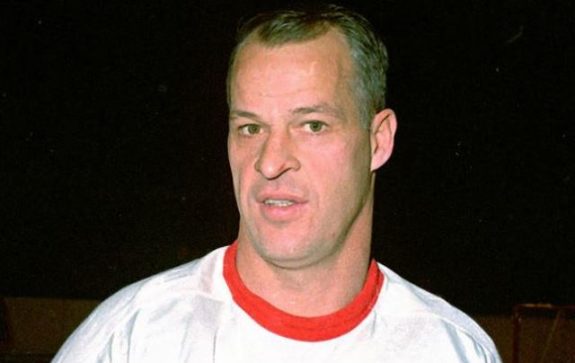
The team rallied around the loss of their young star. Abel was spectacular against the New York Rangers in the Cup Final, scoring seven points in the series. Alas, Pete Babando, an unheralded forward, became the hero. His goal in double-overtime of Game 7 gave the Red Wings their first Stanley Cup championship in six seasons.
The threesome had another brilliant season during the 1950-51 season, as Howe led the league in goals (43) and points (86) for the first time in his career. Abel potted 61 points, Lindsay had 59, and a goaltender named Terry Sawchuck took home the Calder Memorial Trophy as the league’s top rookie.
Despite the individual success, the Montreal Canadiens snuck past the Red Wings in the playoffs, mainly due to the heroics of Maurice Richard. In any event, the following year was one for the ages.
The Red Wings dominated all aspects of the 1951-52 season, and the Production Line was the main reason why. They led the league with a 44-14-12 record, and Howe won the Art Ross and Hart trophies. If that was not enough, the team, which had seven eventual Hall-of-Famers on it, swept both rounds of the playoffs, outscoring opponents 24-5 en route to another Stanley Cup victory.

Unbelievably, that was the last year the original Production Line would be in service. Abel was traded to the Chicago Blackhawks before the 1952-53 season to make room for a gifted young centerman named Alex Delvecchio.
It would be a relatively seamless transition, as Delvecchio tallied 59 points during his first season on the line. Howe also won his third-straight scoring title by producing 95 points, which was an NHL record at the time, while Lindsay was named a First Team NHL All-Star for the fourth-straight season.
The Red Wings faltered in the playoffs that season, but they captured back-to-back Stanley Cups in 1953-54 and 1954-55. Woefully, the team would not win again for many decades, despite continued dominance from their star players. Once Adams traded Lindsay to the Blackhawks following the 1956-57 season, it seemed as though the magic had died.
Howe and Delvecchio continued to terrorize opposing goaltenders into the 1970s, and Frank Maholivch helped form the third installment of the Production Line. Nevertheless, the newest triumvirate was unable to find the playoff success that the first two had managed.
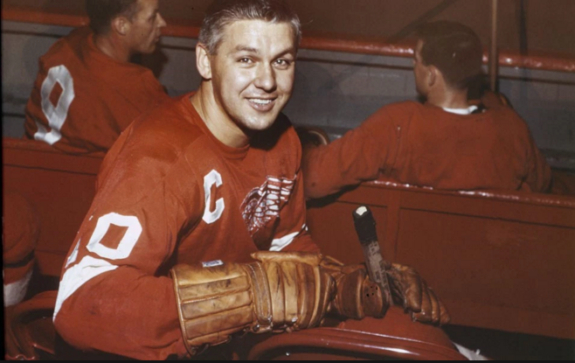
The quartet of Abel, Lindsay, Howe, and Delvecchio combined for four Stanley Cup championships in the 1950s, and a plethora of individual awards. They define an entire generation of Red Wings’ hockey.
The first two versions of the Production Line have an aura surrounding them that surpasses eras. They are not only legendary for the Red Wings but the NHL as a whole.
The Russian Five
The 1970s and mid-1980s were the darkest days in Red Wings’ franchise history. Between 1970-71 and 1985-86, the team made the playoffs just three times. By the 1986-87 season, Steve Yzerman had officially blossomed into the team’s young superstar. Fortunes were starting to change, but the Red Wings were still a long way away from championship contention.
The 1989 NHL Entry Draft completely transformed the entire fabric of the franchise. In the third round, the team selected a wiry Swedish defenseman named Nicklas Lidstrom with the 53rd-overall pick. He turned out to be pretty good.
Likewise, in the fourth round, the team grabbed Russian pivot Sergei Fedorov with the 74th-overall pick, and they added Russian defenseman Vladimir Konstantinov in the 11th round at 221st overall. In the 1990 NHL Entry Draft, they selected Russian winger Slava Kozlov in the third round with the 45th-overall pick.

Now, of course, Lidstrom played a starring role in the team’s revival, but these three Russian players were also massive contributors once they made their NHL debuts.
In the 1993-94 season, Kozlov tallied 34 goals in 77 games while Konstantinov excelled as a bonafide top-pairing defenseman. As for Fedorov, he scored 120 points, winning the Hart Trophy as league MVP, the Lester B. Pearson Award as the NHLPA’s MVP, and the Selke Trophy for being the top defensive forward in hockey.
Related: ‘The Russian Five’ More Than Just a Hockey Documentary
The Red Wings finished with the best record in the Central Division, but they still floundered in the playoffs, losing to the Blackhawks in the second round. Midway through the 1994-95 season, knowing the team was a contender for the Stanley Cup, management traded a third-round pick to the New Jersey Devils for Russian defenseman Slava Fetisov.
The 36-year-old Fetisov was a legendary figure in Russian hockey, having won 13 gold medals across various levels of international competition in his career. He had also played with Fedorov and Konstantinov on a historically renowned CSKA Moscow team in Russia.
He tallied 14 points in 14 regular-season games for the Red Wings, as well as 8 points in 18 playoff games. Fedorov led the team in scoring in the playoffs with 24 points, while Kozlov tied for the team lead in goals with nine. Unfortunately, the Red Wings fell to Fetisov’s former team, the Devils, in the Cup Final.
Despite the sour ending to the season, the Red Wings were so close to the championship they desperately craved. At the start of the 1995-96 season, the team made another trade, sending sniper Ray Sheppard to the San Jose Sharks for veteran Russian center Igor Larionov.
When reflecting on the trade years later in an interview on NHL.com, head coach Bowman mentioned that he thought, “it would be great to get a player with such an enormous hockey IQ and to put all five Russian guys together.”
While he may have been excited to acquire Larionov, there was no way of knowing how impactful the trade would become. Bowman, with Larionov’s insight, decided to put all five Russian players on the ice at the same time. Larionov and Kozlov would flank Fedorov’s wings, while Fetisov and Konstantinov manned the blue line.
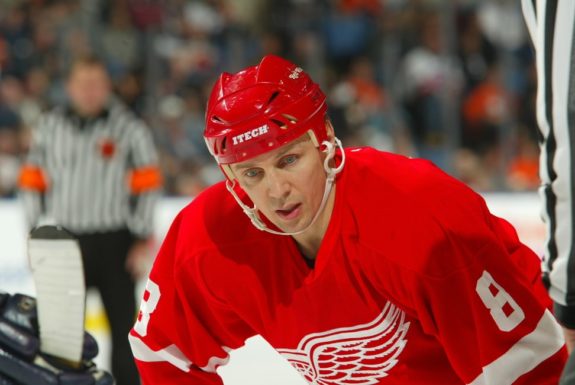
That 1995-96 season seemed like something from a video game for the Russian Five. Both Kozlov and Larionov had over 70 points, while Fedorov led the team in scoring with 107 points. Konstantinov was his typical bruising self, netting 34 points and 139 penalty minutes while posting a remarkable plus-60 rating. Fetisov rounded out the group with 42 points, matching his previous career high.
The team had one of the greatest regular seasons in NHL history, posting a 62-13-7 record. They earned a point in .799% of their games, which is the highest mark in league history. However, the playoffs were a different story, as they struggled to survive in their first two series.
The plucky Winnipeg Jets managed to take them to six games in the first round, while the St. Louis Blues brought them to overtime in Game 7 of the Conference Semifinals. Thankfully, Yzerman scored a timeless goal to win the series.
Regrettably, the Red Wings faltered in the Conference Finals against the Colorado Avalanche. The series started a fierce rivalry, but ultimately, the Red Wings went home early yet again. In a season where so many things went right, they were still incapable of winning it all.
Their historic season fell to the wayside, but the Red Wings were a confident group heading into the 1996-97 season. They added power forward Brendan Shannahan to their already stout team, and the Russian Five had developed intense chemistry throughout the past year. While they all played different styles of hockey, each member of the Russian contingent complemented the others incredibly well.
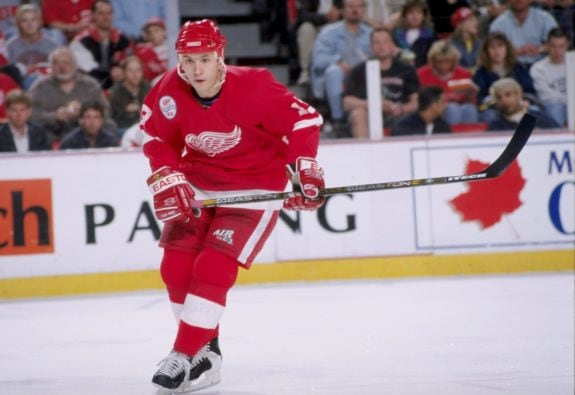
Fedorov was a beautiful skater that possessed jaw-dropping skills in all facets of the game, and Konstantinov provided steady defensive play with bone-crushing hits. Larionov was a cerebral player, who surveyed the ice as well as anyone, while Kozlov had a phenomenal shot that he could rifle past goalies. Lastly, Fetisov was a divine figure whose leadership and all-around effectiveness was irreplaceable.
The Red Wings again qualified for the playoffs, seeking to prove that this year would be different. They cruised to the Conference Finals, where a rematch with the Avalanche awaited them. After losing Game 1 by a 2-1 margin, Kozlov, Fedorov, and Larionov combined for 9 goals and 17 points over the next five games.
The Red Wings overcame their hated rival and went on to sweep the Flyers in the Cup Final. Amazingly, throughout their playoff run, the team only lost four games. In those four games, the Russian Five failed to score a point, whereas the quintet managed to record at least one point in all 16 of the team’s playoff wins.
It seemed that this remarkable collection of Russian talent would continue to dominate the league for years to come, but tragedy struck just days after their cherished victory. Konstantinov, Fetisov, and team masseuse Sergei Mnatsakanov were involved in a limousine accident.
While Fetisov was relatively unscathed from the incident, Konstantinov was in a coma for several weeks, and Mnatsakanov was paralyzed from the waist down. Once Konstantinov awakened, it became clear that he would never play hockey again.
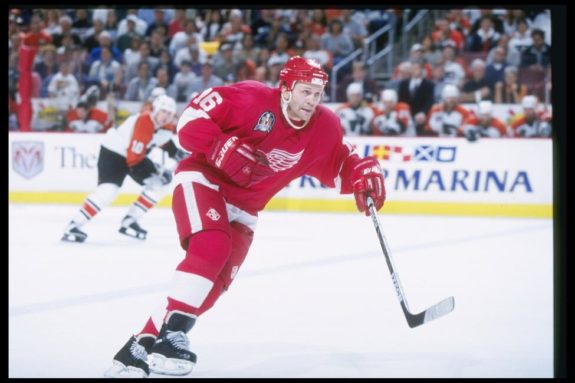
Just days after finally ending a 42-year Stanley Cup drought, the Red Wings were mournful as opposed to ecstatic. At any rate, the team used the tragic incident as motivation for the 1997-98 season, as they were hellbent on winning another Stanley Cup for their friends. The team also wore patches on their jersey that honored the two men victimized by the crash.
While the original iteration of the Russian Five came to an untimely end, the four other players remained, and they were again a significant factor in the team’s success. The Red Wings posted a 44-23-15 record throughout the regular season and coasted back to the Cup Final for a second-straight year.
The Washington Capitals stood no chance and bowed out in four straight games. Over the final three games in the series, each remaining member of the Russian Five core produced at least one point. In one of the most emotional Stanley Cup ceremonies of all time, the team brought Konstantinov out on the ice for the celebration.
Fetisov retired following the championship, while Kozlov was traded to the Buffalo Sabres for Dominik Hasek before the 2001-02 season. Fedorov and Larionov would be instrumental parts of another Stanley Cup victory in 2001-02, but the days of the Russian Five were long over.
The five players only had a few seasons together, but their significance is immortal. They brought the Russian style of hockey into the NHL, illustrating a game based on talent and finesse. The impact they had on the Red Wings lasted for eras, and perhaps still to this day, as someone like Pavel Datsyuk seemed like a direct byproduct of the Russian Five.
The Russian Five were hockey pioneers, helping develop the game into what it is today. They were artists on the ice, and unquestionably one of the more incomparable lines in hockey’s history.
Honorable Mentions
The Two Kids and An Old Goat Line
This line was shortlived, yet entertaining, if not just because of the name itself. Pavel Datsyuk, Boyd Devereaux, and Brett Hull made up the original trio. Datsyuk and Devereaux were both 23 during the 2001-02 season, while Hull was 37.

The line helped the Red Wings win the 2001-02 Stanley Cup, but the next season, a young Henrik Zetterberg ended up taking Devereaux’s place. The second installment of the line continued for two more seasons, as Hull helped the European forwards adjust to the league.
The HUM Line
Likely the least known trio on the list, Paul Henderson, Norm Ullman, and Bruce MacGregor formed this line in the 1960s. Ullman enjoyed three-straight 70-point seasons alongside his two wingers, and the line helped the team make it to the 1965-66 Stanley Cup Final.
The Euro Triplets
Okay, this line does not officially have a nickname, but Datsyuk and Zetterberg are the Euro Twins, so by adding Tomas Holmstrom into the mix, we get the Euro Triplets!
Related: Tomas Holmstrom’s Subtle Brilliance
We know that Datsyuk and Zetterberg are some of the best players of their era, but Holmstrom added a different dynamic to the mix. His tenacious antics in front of the net opened up more ice for the two playmakers, while also blocking the goalie’s sightline. Add in a couple of Holmstrom’s patented deflections, and you have a highly effective line combination.
The trio starred for the Red Wings in their 2007-08 Stanley Cup championship, and several seasons afterward.
The MLB Line
Similar to the previous trio, this line combination did not have an official nickname. That may come with time, however, as Anthony Mantha, Dylan Larkin, and Tyler Bertuzzi enjoyed great success together.
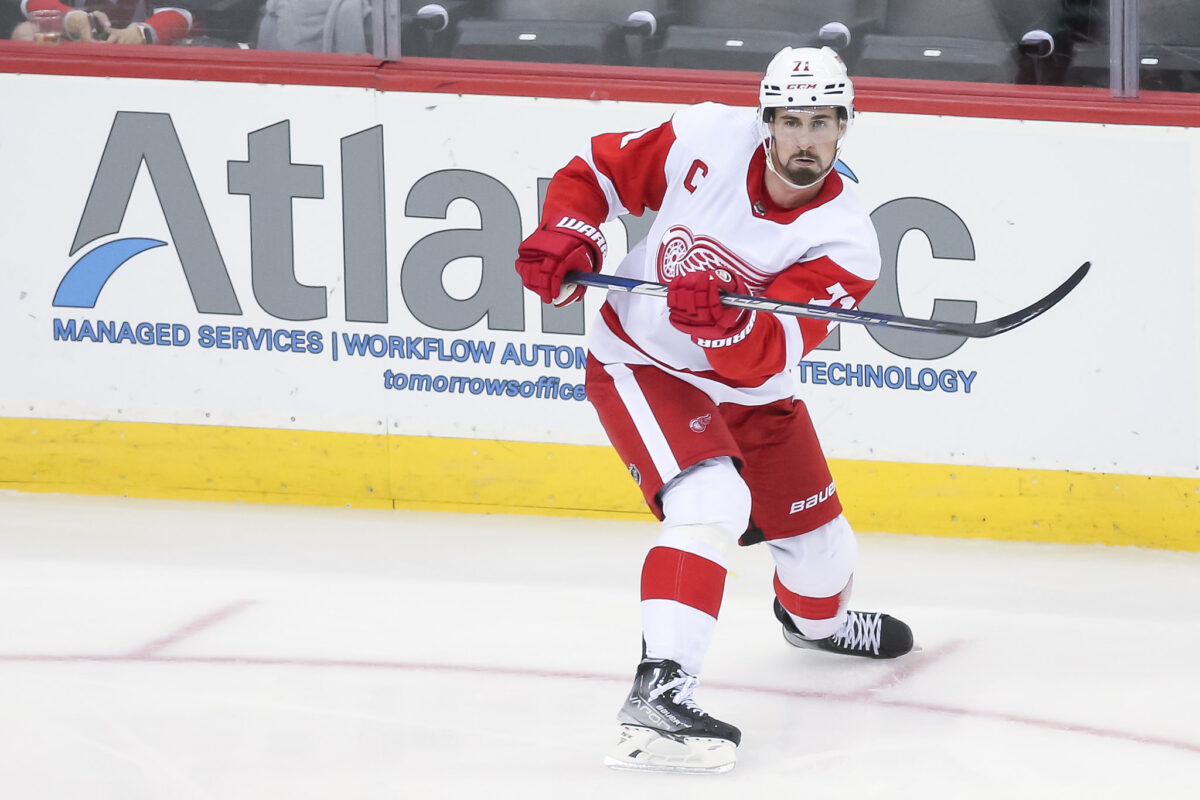
During a six-game stretch at the end of the 2018-19 season, the three players accounted for 38 points. Through their first four games of the 2019-20 season, they accounted for 20 points.
